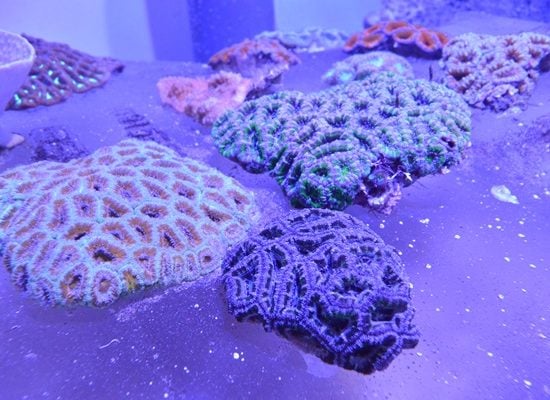One of the most buzzed about art projects in the months leading up to the third edition of the New Orleans biennial, “Prospect.3” has been Glenn Kaino‘s Tank (2014) for which the artist has built giant aquariums that will hold resin casts of armored military tanks that serve as a soil of sorts for regenerating coral reefs. What will start as a small amount of coral in the aquarium tanks will grow over the course of the biennial, which opens Saturday October 25. The piece is meant to comment on a theme with particular relevance for New Orleans residents: destruction and regeneration.
It has been quite a year for the Los Angeles-based artist. This past July, the City of Los Angeles commissioned Kaino, 42, to create a public artwork as part of the initiative to replace the Sixth Street Viaduct, a bridge that connects the arts district in downtown LA with the neighborhood of Boyle Heights, where Kaino grew up. In addition to a solo show at Honor Fraser Gallery planned for early next year, he currently has a major solo show “Leviathan,” at Kavi Gupta’s Elizabeth Street space in Chicago (through December 20).
The artist also has an ongoing standout work at the second edition of Washington D.C.’s 5×5 Project. Bridge, a sweeping sculptural work installed in an historic Naval building, challenges traditional notions of bronze monuments. At first glance, the work appears to be an elegant footbridge with suspended gold objects for slats. But upon closer inspection, each of the bronze slats is revealed to be in the shape of an arm. They are, in fact, painted casts of the arm of Olympic gold medalist Tommie Smith who raised his fist in a Black Power salute as an act of protest during the medal ceremony at the 1968 Olympics, and for which he was suspended from the U.S. Team.
We caught up with the artist at his show at Kavi Gupta to discuss his wide-ranging and thought-provoking conceptual work.
“In general, my practice involves finding spaces in between existing bodies of knowledge,” explains the affable and energetic artist. “The term I use is ‘kit-bashing,’ an old sci-fi model maker’s term for making something without the instructions, like taking a model kit, taking all the pieces out and making whatever you want to make,” says Kaino. “My studio sort of functions that way in the way that I apply my ideas to different systems of being and knowing.”
The show takes on subjects that range from weighty issues like the recent protests in Ferguson, Missouri to lighter, more humorous ones like the practice in hip-hop circles of mixing grape Snapple with pricey Opus One wine (one of Kaino’s sculptures, A Plank for Every Pirate (2014), features wood beams, string, and an empty bottle of Opus One).
The show at Kavi Gupta, in which rocks are a recurring theme, began taking shape in 2012 during a visit to Cairo after he was chosen to represent the U.S. in the now indefinitely postponed Cairo biennial. Reflecting on the violence and unrest in Tahir square as a site of protest, the artist recounted how he picked up a rock there and took it home with him. “I was thinking about it and the value of that rock is really when it’s in the air. When it’s on the ground, it’s rubble. When it’s in the hand of an activist, there is no guarantee that there will be an opportunity to throw it or that it will be thrown. When it’s in the air, it’s vital, it’s alive. It hits its mark and then it’s on the ground and it’s inert again.”
Kaino says he asked friends in Istanbul to send him some rocks. Soon after, boxes of rocks from “different networks of friends in different zones all over the world” started showing up at his studio. Looking at his work, Suspended Animation (2014), composed of a series of rocks lined up on a conveyor belt, he tells of their origins: “These are Portugal, China, Russia, Syria, Athens, Crimea, Yemen” along with the newest additions, stones from Ferguson where he made a side trip while in St. Louis, recently, to meet with activists and protesters.
In several works that each bear the palindromic title Now Do I Repay A Period Won (2014), Kaino threw rocks at rectangular pieces of polished steel arranged in the shape of the U.S. embassies in the respective cities around the world. “Every record of a throw becomes a microcosm,” he says.
Kaino enlisted the help of a network of 3D printers who collaboratively produced a pile of bright multi-colored PLA-printed rocks arranged next to a gallery wall. The work is called Don’t Bring a Gameboy to a Gunfight (2014).
A cinderblock suspended by a rope dangles precariously above a glass house made from a model of an Indonesian apartment complex in a dense urban area for Stones Throw (Indonesia). The work, according to Kaino, is a meditation on the idiom that people in glass houses shouldn’t throw stones, which he thinks has less to do with hypocritical behavior than it does with “refusal to acknowledge one’s own vulnerability.”
“I hope to propose that the work here tries to ask more questions than it answers,” says Kaino of the issues he is attempting to address. “People want to find quick answers and I don’t think there is a quick answer.”
